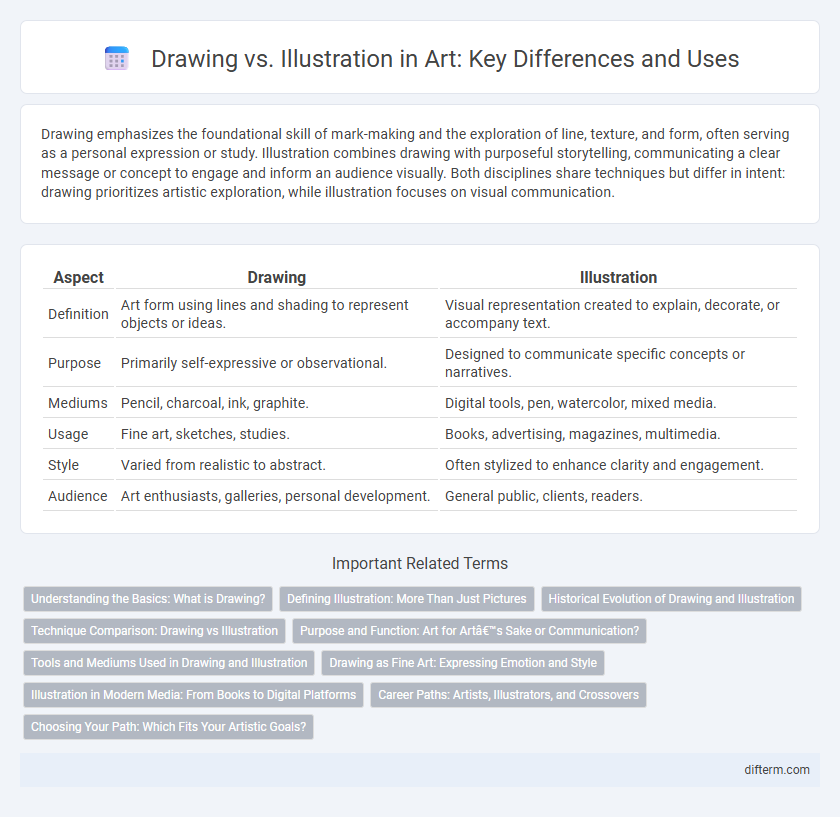Drawing emphasizes the foundational skill of mark-making and the exploration of line, texture, and form, often serving as a personal expression or study. Illustration combines drawing with purposeful storytelling, communicating a clear message or concept to engage and inform an audience visually. Both disciplines share techniques but differ in intent: drawing prioritizes artistic exploration, while illustration focuses on visual communication.
Table of Comparison
| Aspect | Drawing | Illustration |
|---|---|---|
| Definition | Art form using lines and shading to represent objects or ideas. | Visual representation created to explain, decorate, or accompany text. |
| Purpose | Primarily self-expressive or observational. | Designed to communicate specific concepts or narratives. |
| Mediums | Pencil, charcoal, ink, graphite. | Digital tools, pen, watercolor, mixed media. |
| Usage | Fine art, sketches, studies. | Books, advertising, magazines, multimedia. |
| Style | Varied from realistic to abstract. | Often stylized to enhance clarity and engagement. |
| Audience | Art enthusiasts, galleries, personal development. | General public, clients, readers. |
Understanding the Basics: What is Drawing?
Drawing is the fundamental art form involving the creation of marks on a surface to represent objects, ideas, or emotions using tools such as pencils, charcoal, or ink. It emphasizes skillful line work, shading, and composition to capture form, texture, and perspective. Unlike illustration, drawing often serves as a foundational technique for various artistic expressions rather than a purely narrative or commercial purpose.
Defining Illustration: More Than Just Pictures
Illustration extends beyond simple pictures by combining visual storytelling with clear communication to convey complex ideas and narratives. It merges artistic skill with purposeful design, creating imagery that enhances understanding across media such as books, advertisements, and digital platforms. Unlike basic drawing, illustration prioritizes context and message, making it a vital tool in visual communication and branding.
Historical Evolution of Drawing and Illustration
Drawing originated as a fundamental artistic practice in prehistoric times, serving as a primary method for humans to visually communicate and document their surroundings. Illustration evolved later as a specialized form of drawing, becoming prominent during the Middle Ages with illuminated manuscripts and expanding in the 19th century through print media and advertising. The historical evolution of drawing and illustration reflects shifts in cultural, technological, and commercial contexts, with drawing emphasizing foundational skill and personal expression, while illustration focuses on narrative clarity and mass communication.
Technique Comparison: Drawing vs Illustration
Drawing emphasizes fundamental skills such as line work, shading, and form, relying primarily on pencils, charcoal, or ink to create detailed, textured images. Illustration combines drawing techniques with digital tools and mixed media, often incorporating color and narrative elements to convey specific concepts or stories. While drawing centers on observational accuracy and craftsmanship, illustration focuses on communicative impact and stylistic versatility.
Purpose and Function: Art for Art’s Sake or Communication?
Drawing often serves as an expressive form of art created for art's sake, emphasizing personal creativity and visual exploration. Illustration, by contrast, functions primarily as a communication tool designed to convey specific messages or support narratives in books, advertisements, and media. While both utilize similar techniques, their core purposes diverge--drawing prioritizes artistic expression, whereas illustration prioritizes clarity and storytelling.
Tools and Mediums Used in Drawing and Illustration
Drawing primarily utilizes traditional tools such as graphite pencils, charcoal, ink pens, and colored pencils on paper or sketchpads, emphasizing precision and texture. Illustration incorporates a broader range of mediums including digital tablets, software like Adobe Photoshop and Illustrator, watercolors, acrylics, and mixed media to create versatile, visually engaging artwork. Both disciplines demand mastery of tool-specific techniques to effectively communicate visual narratives or artistic concepts.
Drawing as Fine Art: Expressing Emotion and Style
Drawing as fine art emphasizes the artist's emotional expression and unique style through line, texture, and form. This traditional medium captures the raw essence of creativity, allowing for personal interpretation and depth beyond representational accuracy. The nuanced use of shading and composition in drawing often conveys complex feelings and artistic individuality, distinguishing it from illustration's more narrative-driven approach.
Illustration in Modern Media: From Books to Digital Platforms
Illustration plays a pivotal role in modern media, enhancing storytelling across books, advertising, video games, and digital platforms. Unlike traditional drawing, illustration combines artistry with narrative purpose, using digital tools like Adobe Illustrator and Procreate to create dynamic visuals that engage diverse audiences. The integration of illustration in multimedia projects boosts user experience, brand identity, and visual communication in today's digital landscape.
Career Paths: Artists, Illustrators, and Crossovers
Artists specializing in drawing often pursue careers in fine arts, gallery exhibitions, and conceptual projects, showcasing personal expression through traditional or digital media. Illustrators typically work in commercial fields such as publishing, advertising, and animation, creating visuals that communicate specific narratives or ideas for clients. Crossovers between drawing and illustration enable professionals to blend artistic creativity with commercial demands, expanding opportunities in multimedia design, editorial work, and freelance commissions.
Choosing Your Path: Which Fits Your Artistic Goals?
Drawing emphasizes foundational skills and fine motor control, serving as a versatile base for various art forms. Illustration combines drawing with storytelling and commercial intent, often tailored for specific audiences or products. Artists should evaluate their passion for narrative versus technique to determine which path aligns best with their creative objectives.
Drawing vs Illustration Infographic

 difterm.com
difterm.com